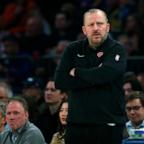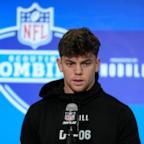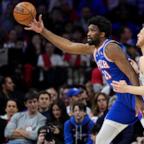Despite COVID-related postponements, NBA trainers, executives don't see shutdown ahead
Despite nine COVID-related postponements since Sunday, team health officials, team executives and sources around the NBA familiar with its health and safety protocols say that, while the situation remains fluid, they don't expect it to warrant a shutdown of the league or moving back to a bubble.
The officials reaffirmed faith in the NBA's protocols and say that issues were expected as the league navigates its first month outside a bubble, especially with cases spiking across the United States.
One Western Conference head athletic trainer, who spoke on the condition of anonymity about the events of the past week, said, "It's just a reflection of what's going on in every city. I mean, we're doing lots of things, but we're not living in a bubble [anymore]."
Other officials whom ESPN spoke with in recent days emphasized that the situation remains incredibly fluid, but they also weren't surprised by these issues or postponements. They also do not believe there were grave breakdowns in any one area -- especially in the NBA's detailed protocols -- that have led to more infections among players or staff.
All of the officials independently pointed to a number of key factors outside the NBA's control, starting with predictions made by epidemiologists and infectious disease experts months ago about how these winter months were going to be America's most difficult during the pandemic.
"All the stars are aligned in the wrong place as you go into the fall and winter season, with people congregating at home indoors," Dr. Anthony Fauci, the country's top infectious disease expert, told The Washington Post in October. "You could not possibly be positioned more poorly."
Those predictions have come true -- with a record numbers of deaths on several recent days. An average of nearly 250,000 new COVID-19 infections has been reported every day during the past week, according to data from Johns Hopkins University.
"I don't know how you can live in the public and not reflect, healthwise, what's going on in the public," the Western Conference head athletic trainer said.
Further, team health officials pointed to other sports, such as the NFL, college football and college basketball, and how they all faced COVID-related issues in their own seasons outside a bubble, which drove home the reality that the NBA would face challenges as it prepared to do the same, something NBA commissioner Adam Silver acknowledged before the season.
But a key talking point was the fact that the NBA is coming off playing the end of last season in a bubble -- held at Walt Disney World in Orlando, Florida -- in which there were no positive player cases. The bubble's success, these officials said, created a double-edged sword that gave the league and its protocols significant credibility but perhaps a sheen of unrealistic invincibility. The summer months also were less dire in terms of cases and deaths as the current situation.
"Nobody wanting to go back to a long bubble period of play has put us in this position," said one Western Conference general manager. "It is doable but suboptimal."
The NBA enhanced its protocols by introducing new restrictions this week that were agreed upon by the players' union and will last for at least the next two weeks. Some of those restrictions include prohibiting non-team guests in road hotel rooms and requiring players to wear masks on the bench at all times.
There is the hope that these stricter protocols will help carry teams through the current nationwide surge and thus won't need to be in place all season, team health sources said.
In a memo to teams Wednesday, which was first reported by ESPN's Tim Bontemps, the NBA introduced what may prove to be another layer of protection with regard to testing. Already, players and most team staff are tested twice a day -- a rapid test and a polymerase chain reaction (PCR) test -- but the league outlined plans for a potential third PCR test that would occur only on game days with local providers in all 28 NBA cities. The game-day test would serve as a backup option for any issues transporting or receiving results of other tests and help ensure that everyone is clear to participate in that day's game.
The NBA didn't announce the schedule for the second half of its season principally so it could accommodate any postponed or canceled games tied to COVID, a nod to internal expectations that issues would likely occur, as Silver has previously reiterated.
In a Dec. 21 conference call with reporters, Silver mentioned that the league has "prepared for all contingencies," but in talks with team health officials and league sources familiar with the health and safety protocols, another bubble was seen more as an absolute last resort that all involved parties would seek to avoid at all costs.
In terms of what it would take to suspend a season, the only issue that these officials mentioned was a scenario in which it was found that players were transmitting the virus to one another during games. But the NBA has yet to find evidence of such a scenario, league sources say.
In its contact-tracing program, the NBA uses CDC guidelines to define "close contact" -- and through Second Spectrum tracking data, the league has found that players who play 30-40 minutes a night aren't typically within 6 feet of other players for more than five or six minutes during a game, which would fall outside the CDC-defined terms of "close contact."
For now, several team health officials and indeed league officials say that even if the protocols in place are sound, the season will be imperfect.
"This is essentially a moving bubble that gets popped every now and then," said one Western Conference athletic training official.



